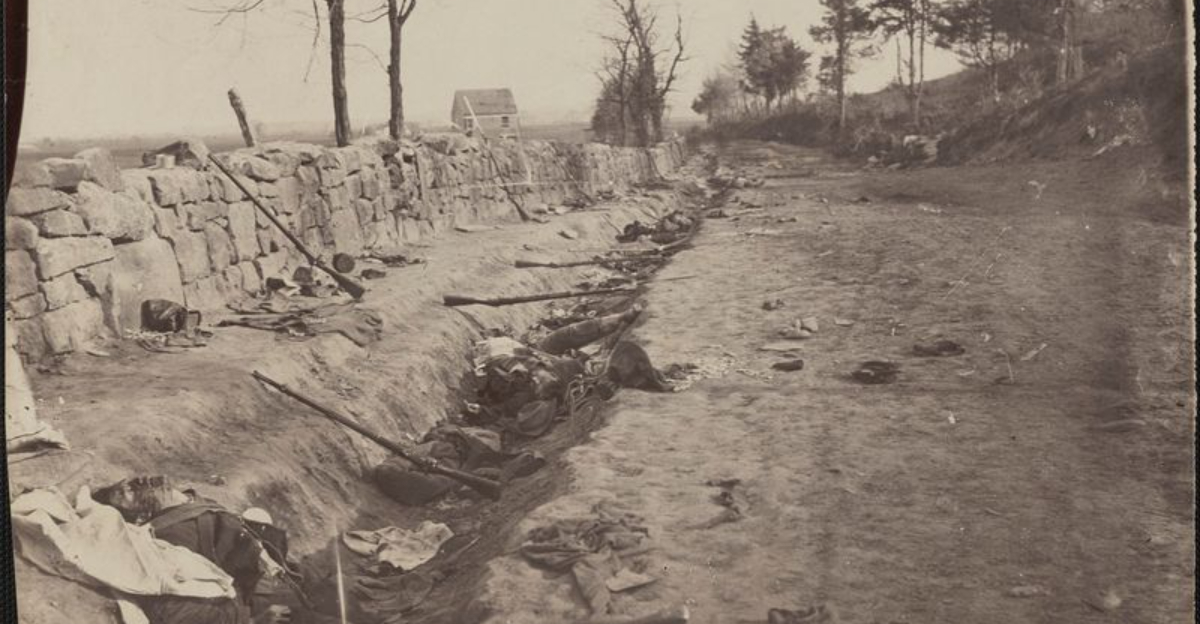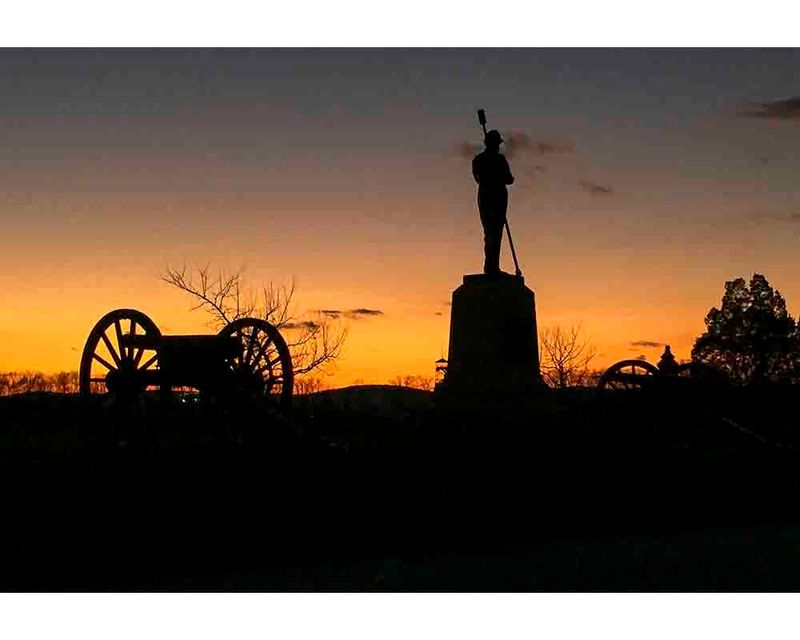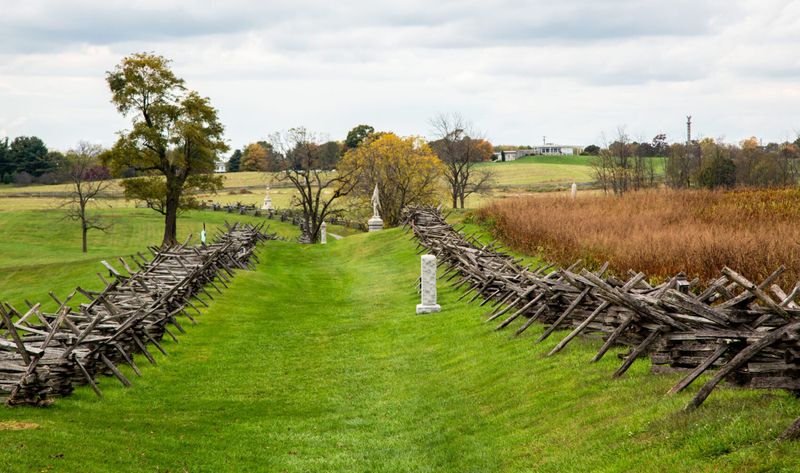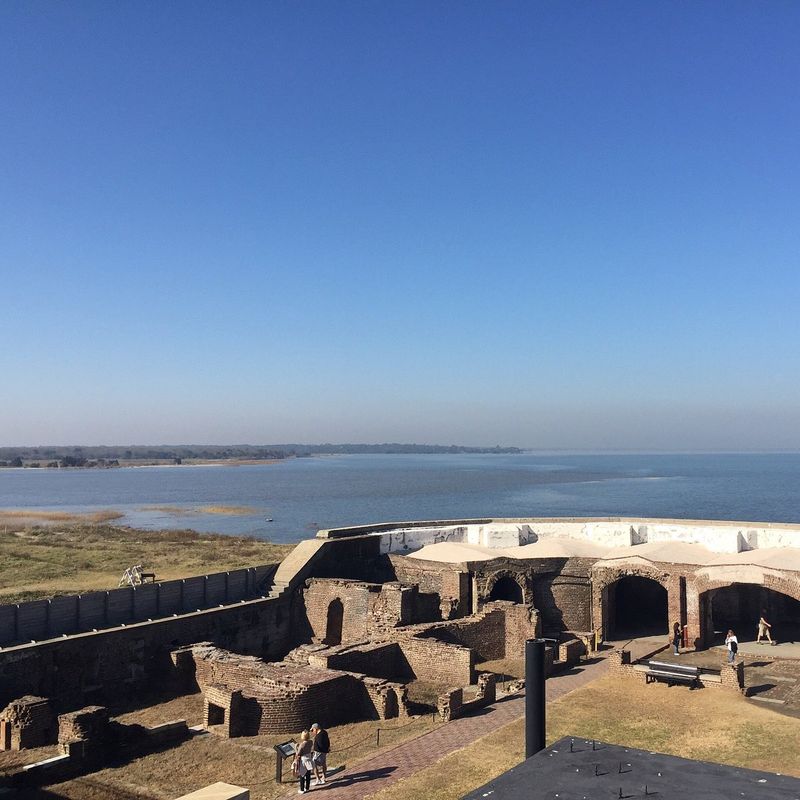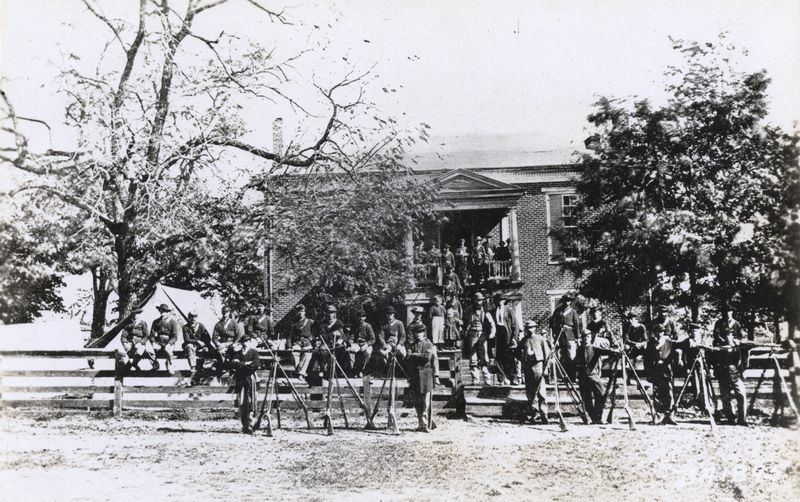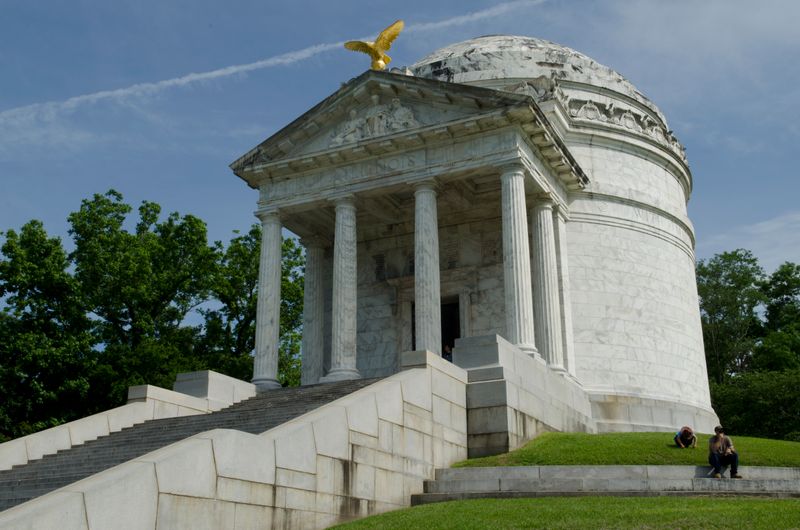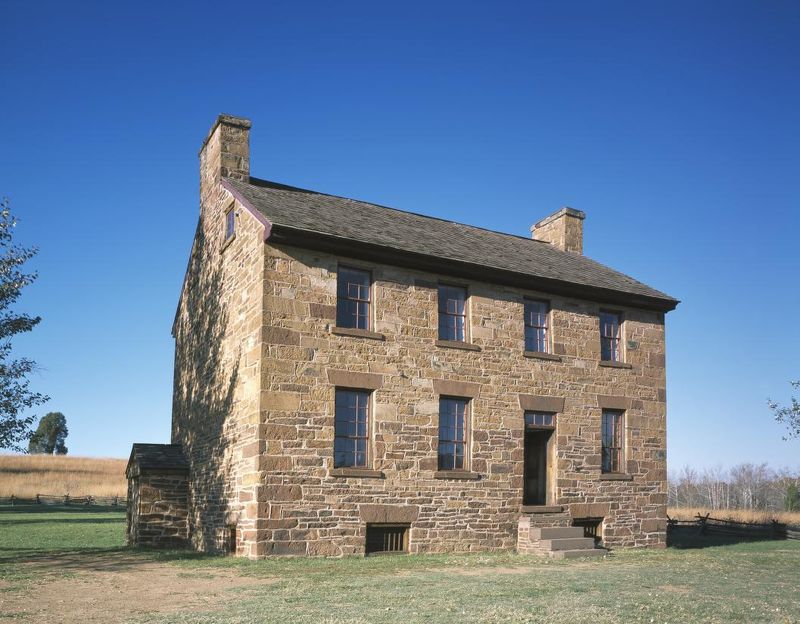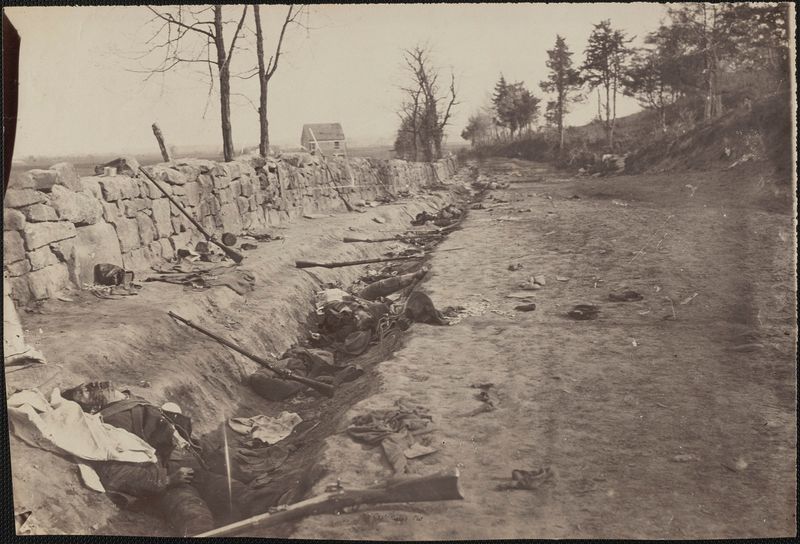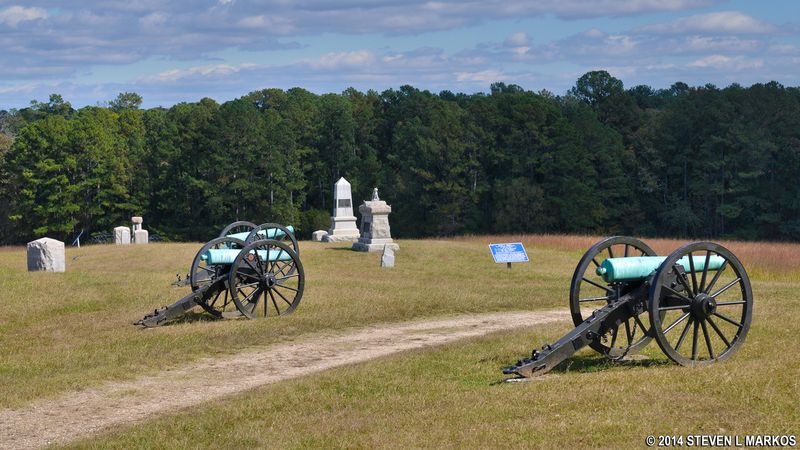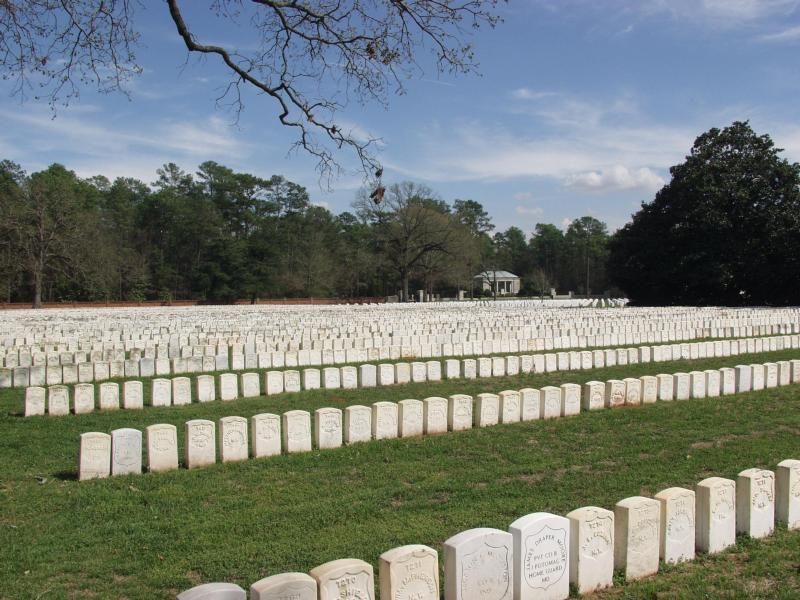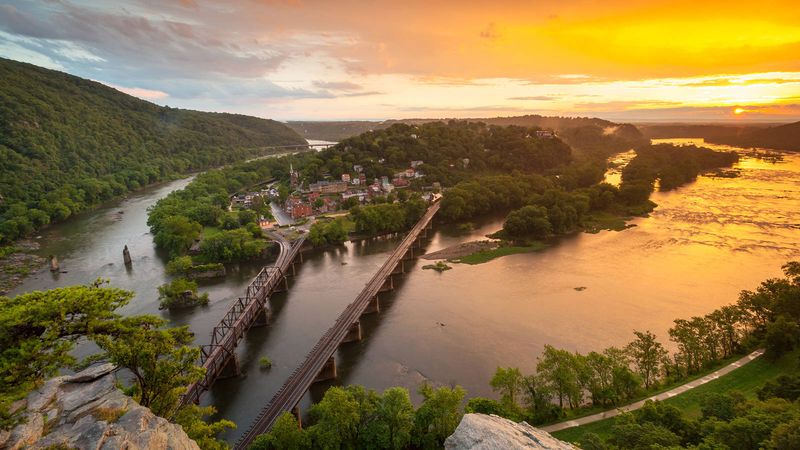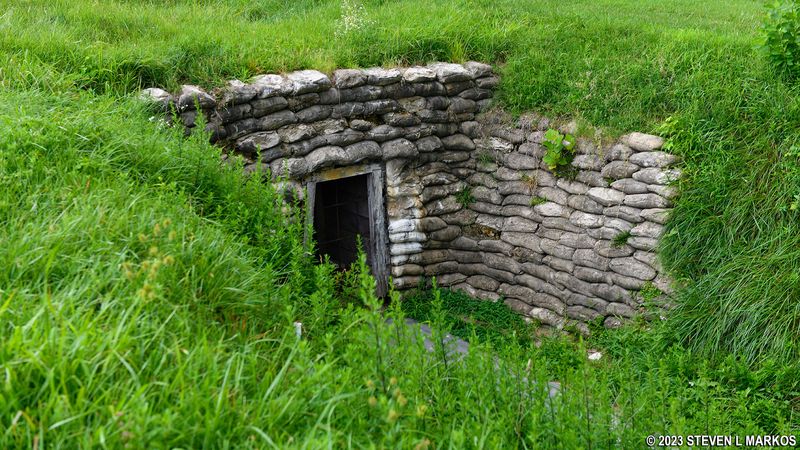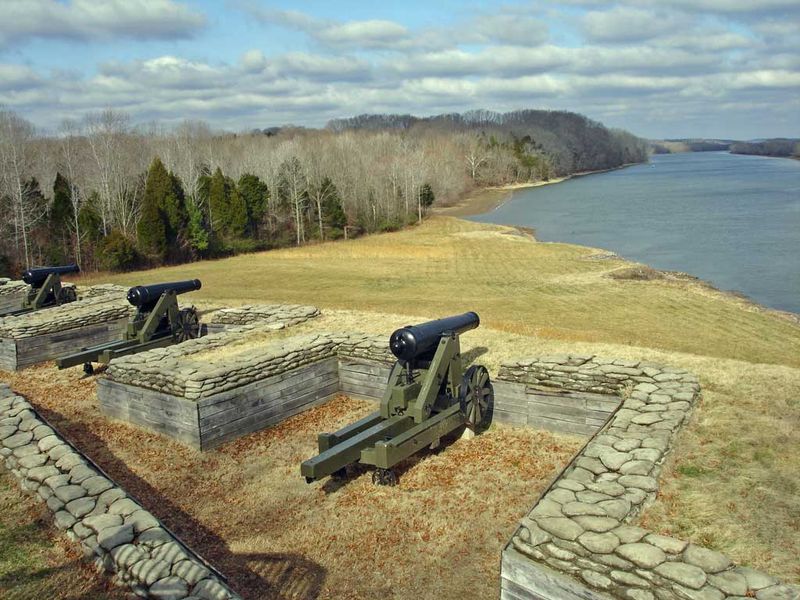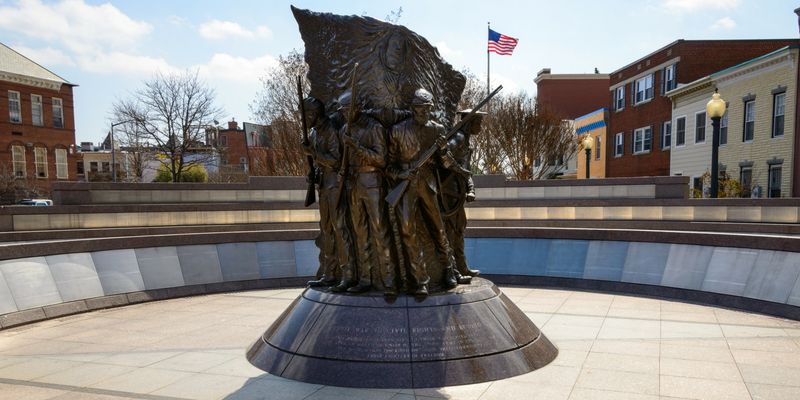The American Civil War tore our nation apart, leaving scars still visible today. Between 1861 and 1865, Americans fought against Americans in a conflict that would determine the future of slavery and reshape the United States forever. These fourteen historic sites preserve the battlefields, prisons, and landmarks where history unfolded, allowing us to touch the past and understand the true cost of this devastating war.
1. Gettysburg: Where the Tide Turned
Standing on the rolling hills of Gettysburg feels like stepping back in time to July 1863. The air seems heavier here, knowing that over 50,000 Americans became casualties during three days of brutal fighting.
Monuments dot the landscape where Union soldiers desperately held positions at Little Round Top and where Pickett’s Charge met its bloody end. The site where Lincoln later delivered his famous 172-word address reminds visitors that this hallowed ground represented not just death, but a new birth of freedom.
The meticulously preserved battlefield allows modern visitors to walk in soldiers’ footsteps and understand how this Pennsylvania crossroads became the war’s turning point.
2. Antietam’s Bloody Lanes
The tranquil Maryland countryside belies Antietam’s brutal history as America’s bloodiest single day. On September 17, 1862, nearly 23,000 soldiers fell dead or wounded along Antietam Creek and the infamous Sunken Road, later renamed Bloody Lane.
Farmers’ fields transformed into killing grounds as Union and Confederate forces clashed in cornfields, across bridges, and through woods. The strategic Union victory gave Lincoln the confidence to issue the Emancipation Proclamation, fundamentally changing the war’s purpose.
Walking these peaceful fields today, it’s almost impossible to imagine the chaos and carnage that unfolded here—yet the preserved landscape tells the story of sacrifice that altered our nation’s course.
3. Fort Sumter: Where It All Began
Harbor breezes sweep across this small island fortress in Charleston Harbor where the first shots of the Civil War echoed on April 12, 1861. Confederate artillery bombarded the Union-held fort for 34 hours until Major Robert Anderson surrendered.
The fort’s brick walls still show battle damage from both this initial bombardment and later Union attempts to retake the symbolic stronghold. What began here as a dispute over federal property became the opening salvo in a four-year struggle that would claim over 750,000 American lives.
Accessible only by boat, the isolated position of Fort Sumter helps modern visitors understand the strategic and psychological importance of this seemingly small military outpost.
4. Appomattox Court House: The End of the Beginning
The humble McLean House seems too ordinary for the extraordinary events that unfolded inside. Here, on April 9, 1865, Generals Lee and Grant met to negotiate the surrender that effectively ended the Civil War.
The simple farmhouse and surrounding village have been meticulously restored to their 1865 appearance. Visitors can stand in the very room where Lee, dressed in his finest uniform, surrendered to Grant, who arrived in a mud-splattered field uniform.
Grant’s generous terms—allowing Confederate soldiers to return home with their horses and personal weapons—set the tone for healing. This Virginia countryside witnessed not just the end of fighting, but the first steps toward reunification.
5. Shiloh: Innocence Lost
Named after a small log church, Shiloh became synonymous with slaughter after April 1862. The battle shocked Americans who still believed the war would be brief and relatively bloodless.
The peaceful Tennessee riverside belies the horror of what happened here—23,000 casualties in just two days of fighting. The haunting Bloody Pond, where wounded soldiers from both sides crawled to drink, still stands as a silent witness to suffering.
Touring Shiloh reveals how unprepared both armies were for modern warfare. Union forces, initially surprised and driven back, eventually prevailed, but at such cost that General Sherman later remarked, “I saw the horrors of war at Shiloh.”
6. Vicksburg: The Fortress City
Perched high on bluffs overlooking the Mississippi River, Vicksburg seemed impregnable. Confederate forces held this natural fortress until Grant’s 47-day siege starved the city into submission on July 4, 1863.
The elaborate network of trenches, tunnels, and fortifications remains visible today. Visitors can explore both the battlefield and the haunting Vicksburg National Cemetery where over 17,000 Union soldiers rest.
Civilians suffered terribly during the siege, forced to live in caves dug into hillsides to escape constant bombardment. The fall of this strategic stronghold split the Confederacy and gave the Union control of the mighty Mississippi—a turning point Abraham Lincoln called “the key to victory.”
7. Manassas: Illusions Shattered
Picnickers from Washington DC came to watch what they thought would be a quick Union victory at First Manassas in July 1861. Instead, they witnessed chaos as defeated Union troops fled back toward the capital.
The battlefield’s rolling Virginia meadows and the stone house that served as a field hospital preserve the story of not one, but two significant Confederate victories. Thomas Jackson earned his nickname “Stonewall” here for his brigade’s steadfast defense of Henry Hill during First Manassas.
A year later, the armies clashed again on the same ground, with similar results. These battlefields remind us how both sides gradually realized this would be a long, bloody conflict requiring total national commitment.
8. Fredericksburg: Futile Courage
“It is well that war is so terrible, or we should grow too fond of it,” Robert E. Lee remarked as he watched Union soldiers being slaughtered below Marye’s Heights. The stone wall at the base of this ridge became a killing zone where wave after wave of Federal troops fell in December 1862.
The town of Fredericksburg itself bears scars from the urban combat that preceded the main battle. Bullet holes still mark buildings where Confederate sharpshooters fired on Union soldiers crossing the Rappahannock River.
Walking the Sunken Road where Confederate troops sheltered behind the stone wall, visitors can appreciate the futility of the Union’s frontal assaults—a tragic lesson in military tactics paid for in blood.
9. Chickamauga: Victory Without Gain
The name “Chickamauga” comes from Cherokee words meaning “river of death”—a fitting name for the site of the bloodiest two-day battle in the Western Theater. The dense Georgia woods created confusion where units became lost and soldiers fought in isolated pockets.
Snodgrass Hill, where General George Thomas earned his nickname “The Rock of Chickamauga” by holding firm while the rest of the Union army retreated, stands as a testament to individual courage amid collective failure. Despite winning this September 1863 battle, the Confederacy couldn’t capitalize on their victory.
The nearby battles for Chattanooga soon reversed Confederate fortunes, securing Union control of Tennessee and opening the door to Georgia and Sherman’s March to the Sea.
10. Andersonville: The Depths of Suffering
No battlefield in the Civil War witnessed more prolonged suffering than Andersonville Prison. This overcrowded Confederate POW camp held more than 45,000 Union soldiers during its 14 months of operation.
Almost 13,000 men died here from disease, malnutrition, and exposure after being crammed into a 26-acre pen designed for a fraction of that number. The reconstructed stockade walls and Providence Spring—said to have miraculously appeared during a thunderstorm—stand as reminders of both desperation and hope.
The rows of white markers in the adjacent cemetery create a powerful visual testament to the war’s inhumanity. Andersonville remains the most sobering reminder that war’s cruelty extends far beyond the battlefield.
11. Harpers Ferry: Flashpoint for Conflict
The dramatic landscape where the Potomac and Shenandoah rivers meet made Harpers Ferry both strategically valuable and militarily indefensible. John Brown’s 1859 raid on the federal armory here failed to ignite the slave uprising he hoped for but succeeded in heightening tensions that led to war.
During the conflict, the town changed hands eight times. Its position at the gateway to the Shenandoah Valley made it crucial for both armies.
The restored town with its steep streets, stone steps, and historic buildings helps visitors understand the geography that made this place so important. The combination of natural beauty and violent history creates a powerful contrast that defines much of the Civil War experience.
12. Petersburg: The Long Siege
The nine-month siege of Petersburg foreshadowed the trench warfare of World War I. Miles of zigzagging earthworks, still visible today, protected soldiers from constant sniper fire and artillery.
Desperate to break the stalemate, Union troops dug a tunnel under Confederate lines and detonated four tons of gunpowder, creating a massive crater. The subsequent battle became a Union disaster when attacking soldiers became trapped in the steep-sided hole.
The preserved battlefield shows how the nature of warfare changed as the conflict dragged on. By 1864, gone were the dashing cavalry charges and heroic frontal assaults—replaced by the grinding attrition of siege warfare that eventually exhausted the Confederacy and led to Richmond’s fall.
13. Fort Donelson: The Rise of Grant
Before Ulysses S. Grant became the Union’s greatest general, he earned his reputation at this Tennessee fort overlooking the Cumberland River. February 1862 found Confederate forces huddled behind earthen walls as Union gunboats bombarded their position.
After a failed breakout attempt, Confederate General Buckner asked for surrender terms. Grant’s famous reply—”No terms except unconditional and immediate surrender”—earned him his nickname and national fame.
The fort’s riverside batteries, which successfully drove off Union gunboats, contrast with the vulnerable land side where Grant’s troops eventually broke through. This early Union victory opened the Tennessee and Cumberland rivers to Federal forces, beginning the long campaign to divide the Confederacy.
14. African American Civil War Memorial: The Forgotten Heroes
Until recently, history books largely overlooked the 200,000+ Black soldiers and sailors who fought for the Union. This powerful Washington D.C. memorial, featuring “The Spirit of Freedom” bronze sculpture and a wall of names, rectifies that injustice.
Black troops faced prejudice from their own army, receiving lower pay than white soldiers and typically assigned the most dangerous or demeaning duties. Despite this, they fought with extraordinary courage, earning 25 Medals of Honor.
The adjacent museum showcases personal stories of these soldiers, many of whom were formerly enslaved. Their service proved crucial to Union victory and helped secure citizenship rights in the postwar constitutional amendments—a transformation from property to patriots.
